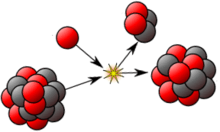Positron emission
| Nuclear physics |
|---|
 |
| Nucleus · Nucleons (p, n) · Nuclear force · Nuclear structure · Nuclear reaction |
|
Nuclear models and stability |
|
Nucleosynthesis topics Nuclear fusion Processes: Stellar · Big Bang · Supernova Nuclides: Primordial · Cosmogenic · Artificial |
|
Scientists Alvarez · Becquerel · Bethe · A.Bohr · N.Bohr · Chadwick · Cockcroft · Ir.Curie · Fr.Curie · Pi.Curie · Skłodowska-Curie · Davisson · Fermi · Hahn · Jensen · Lawrence · Mayer · Meitner · Oliphant · Oppenheimer · Proca · Purcell · Rabi · Rutherford · Soddy · Strassmann · Szilárd · Teller · Thomson · Walton · Wigner |
Positron emission or beta plus decay (β+ decay) is a subtype of radioactive decay called beta decay, in which a proton inside a radionuclide nucleus is converted into a neutron while releasing a positron and an electron neutrino (νe).[1] Positron emission is mediated by the weak force. The positron is a type of beta particle (β+), the other beta particle being the electron (β−) emitted from the β− decay of a nucleus.
An example of positron emission (β+ decay) is shown with magnesium-23 decaying into sodium-23:
- 23
12Mg
→ 23
11Na
+
e+
+
ν
e
Because positron emission decreases proton number relative to neutron number, positron decay happens typically in large "proton-rich" radionuclides. Positron decay results in nuclear transmutation, changing an atom of one chemical element into an atom of an element with an atomic number that is less by one unit.
Positron emission should not be confused with electron emission or beta minus decay (β− decay), which occurs when a neutron turns into a proton and the nucleus emits an electron and an antineutrino.
Discovery of positron emission
In 1934 Frédéric and Irène Joliot-Curie bombarded aluminium with alpha particles to effect the nuclear reaction 4
2He
+ 27
13Al
→ 30
15P
+ 1
0n
, and observed that the product isotope 30
15P
emits a positron identical to those found in cosmic rays by Carl David Anderson in 1932.[2] This was the first example of
β+
decay (positron emission). The Curies termed the phenomenon "artificial radioactivity," since 30
15P
is a short-lived nuclide which does not exist in nature. The discovery of artificial radioactivity would be cited when the husband and wife team won the Nobel Prize.
Positron-emitting isotopes
Isotopes which undergo this decay and thereby emit positrons include carbon-11, potassium-40, nitrogen-13, oxygen-15, aluminium-26, sodium-22, fluorine-18, and iodine-121. As an example, the following equation describes the beta plus decay of carbon-11 to boron-11, emitting a positron and a neutrino:
Emission mechanism
Inside protons and neutrons, there are fundamental particles called quarks. The two most common types of quarks are up quarks, which have a charge of +2/3, and down quarks, with a −1/3 charge. Quarks arrange themselves in sets of three such that they make protons and neutrons. In a proton, whose charge is +1, there are two up quarks and one down quark. Neutrons, with no charge, have one up quark and two down quarks. Via the weak interaction, quarks can change flavor from down to up, resulting in electron emission. Positron emission happens when an up quark changes into a down quark.[3]
Nuclei which decay by positron emission may also decay by electron capture. For low-energy decays, electron capture is energetically favored by 2mec2 = 1.022 MeV, since the final state has an electron removed rather than a positron added. As the energy of the decay goes up, so does the branching ratio towards positron emission. However, if the energy difference is less than 2mec2, then positron emission cannot occur and electron capture is the sole decay mode. Certain isotopes (for instance, 7
Be
) are stable in galactic cosmic rays, because the electrons are stripped away and the decay energy is too small for positron emission.
Energy conservation
A positron is ejected from the parent nucleus, and the daughter (Z-1) atom must shed an orbital electron to balance charge. The overall results is that the mass of two electrons are ejected from the atom (one for the positron and one for the electron), and the beta+ decays is energetically possible only if the mass of the parent atom exceeds the mass of the daughter atom by at least two electron masses (1.02 MeV).
Isotopes which increase in mass under the conversion of a proton to a neutron, or which decrease in mass by less than 2me, cannot spontaneously decay by positron emission.
Application
These isotopes are used in positron emission tomography, a technique used for medical imaging. Note that the energy emitted depends on the isotope that is decaying; the figure of 0.96 MeV applies only to the decay of carbon-11.
The short-lived positron emitting isotopes 11C, 13N, 15O and 18F used for positron emission tomography are typically produced by proton irradiation of natural or enriched targets.[4][5]
References
- ↑ The University of North Carolina at Chapel Hill. "Nuclear Chemistry". Retrieved 2012-06-14.
- ↑ I. Curie and F. Joliot, C. R. Acad. Sci. 198, 254 (1934)
- ↑ How it works:Positron emission
- ↑ Positron Emission Tomography Imaging at the University of British Columbia (accessed 11 May 2012)
- ↑ Ledingham, K W D; McKenna, P; McCanny, T; Shimizu, S; Yang, J M; Robson, L; Zweit, J; Gillies, J M; Bailey, J; Chimon, G N; Clarke, R J; Neely, D; Norreys, P A; Collier, J L; Singhal, R P; Wei, M S; Mangles, S P D; Nilson, P; Krushelnick, K; Zepf, M (2004). "High power laser production of short-lived isotopes for positron emission tomography". Journal of Physics D: Applied Physics. 37 (16): 2341. Bibcode:2004JPhD...37.2341L. doi:10.1088/0022-3727/37/16/019.
External links
-
 The LIVEChart of Nuclides - IAEA with filter on β+ decay
The LIVEChart of Nuclides - IAEA with filter on β+ decay